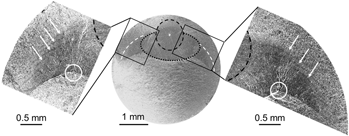Article contents
Crack initiation in the very high cycle fatigue regime of nitrided 42CrMo4 steel
Published online by Cambridge University Press: 07 August 2017
Abstract

Surface treatments such as shot peening, deep rolling, or nitriding are known to be very effective for the protection of a surface against fatigue crack initiation, due to surface hardening and residual compressive stresses introduced below the surface. Thus, crack initiation of cyclically loaded materials occurs predominantly at internal nonmetallic inclusions (NMIs). Two different plasma-nitriding treatments were performed on a quenched and tempered 42CrMo4 cast steel. Ultrasonic fatigue tests were performed up to 109 cycles. Resonant frequency and the nonlinearity parameter were recorded in situ during the fatigue tests. Fractographic analyses were performed by means of scanning electron microscopy in combination with energy-dispersive X-ray spectroscopy. The results showed that nitriding, as expected, led to improvements in both fatigue life and rates of internal crack initiation at NMIs. However, the analysis of in situ parameters revealed that internal crack initiation occurred at stress amplitude levels well below the failure stress amplitude even for repeated loading until the run-out limit of 109 cycles.
- Type
- Articles
- Information
- Journal of Materials Research , Volume 32 , Issue 23: Focus Issue: Mechanical Properties and Microstructure of Advanced Metallic Alloys—in Honor of Prof. Haël Mughrabi PART A , 14 December 2017 , pp. 4305 - 4316
- Copyright
- Copyright © Materials Research Society 2017
Footnotes
Contributing Editor: Gary L. Messing
References
REFERENCES
- 13
- Cited by





